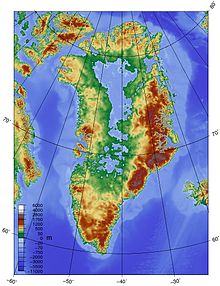
Back انخفاض متوازن التضاغط Arabic Depressió isostàtica Catalan فرورفتگی ترازایستایی Persian 等靜壓凹陷 Chinese


Isostatic depression is the sinking of large parts of the Earth's crust into the asthenosphere caused by a heavy weight placed on the Earth's surface, often glacial ice during continental glaciation.[2] Isostatic depression and isostatic rebound occur at rates of centimeters per year. Greenland is an example of an isostatically depressed region.
- ^ Robinson, Alexander; Calov, Reinhard; Ganopolski, Andrey (June 2012). "Multistability and critical thresholds of the Greenland ice sheet". Nature Climate Change. 2 (6): 429–432. Bibcode:2012NatCC...2..429R. doi:10.1038/nclimate1449. ISSN 1758-678X.
- ^ Lambeck, Kurt (2009), "Glacial Isostasy", in Gornitz, Vivien (ed.), Encyclopedia of Paleoclimatology and Ancient Environments, Encyclopedia of Earth Sciences Series, Dordrecht: Springer Netherlands, pp. 374–380, doi:10.1007/978-1-4020-4411-3_93, ISBN 978-1-4020-4551-6
© MMXXIII Rich X Search. We shall prevail. All rights reserved. Rich X Search